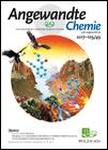版权所有:内蒙古大学图书馆 技术提供:维普资讯• 智图
内蒙古自治区呼和浩特市赛罕区大学西街235号 邮编: 010021

作者机构:Key Laboratory of Applied Surface and Colloid Chemistry Ministry of Education Shaanxi Key Laboratory for Advanced Energy Devices Shaanxi Engineering Lab for Advanced Energy Technology School of Materials Science and Engineering Shaanxi Normal University Xi'an 710119 China Jiangsu Collaborative Innovation Center of Photovoltaic Science and Engineering Jiangsu Province Cultivation Base for State Key Laboratory of Photovoltaic Science and Technology School of Materials Science and Engineering Changzhou University Changzhou 213164 China Dalian National Laboratory for Clean Energy iChEM Dalian Institute of Chemical Physics Chinese Academy of Sciences Dalian 116023 China
出 版 物:《Angewandte Chemie》
年 卷 期:2022年第134卷第33期
学科分类:081704[工学-应用化学] 08[工学] 0817[工学-化学工程与技术]
主 题:CsPbI3 Defect Passivation Hydrazide Perovskite Solar Cells
摘 要:All-inorganic CsPbI 3 perovskite presents preeminent chemical stability and a desirable band gap as the front absorber for perovskite/silicon tandem solar cells. Unfortunately, CsPbI 3 perovskite solar cells (PSCs) still show low efficiency due to high density of defects in solution-prepared CsPbI 3 films. Herein, three kinds of hydrazide derivatives (benzoyl hydrazine (BH), formohydrazide (FH) and benzamide (BA)) are designed to reduce the defect density and stabilize the phase of CsPbI 3 . Calculation and characterization results corroborate that the carboxyl and hydrazine groups in BH form strong chemical bonds with Pb 2+ ions, resulting in synergetic double coordination. In addition, the hydrazine group in the BH also forms a hydrogen bond with iodine to assist the coordination. Consequently, a high efficiency of 20.47 % is achieved, which is the highest PCE among all pure CsPbI 3 -based PSCs reported to date. In addition, an unencapsulated device showed excellent stability in ambient air.